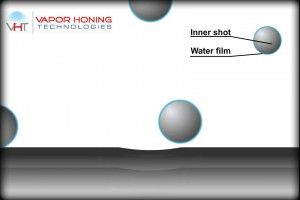The Advantages Of Wet Shot Peening In Manufacturing
 When a metal part is made, if the part is going to be used in high stress applications such as an engine, or turbine, there are certain processes that can be done to the surface area of the part that increase it’s strength and resistance to bending or twisting, and one of those processes is called peening. You may have heard of a ball peen hammer, they have been used by blacksmiths for years to do a similar process by hand, however, modern-day technology has developed machines that repeatedly blast tiny shot, at high speeds in order to clean and treat the entire surface of the part. Once a material has been shot peened it is less likely to twist, crack, or bend because it’s surface has been hardened and strengthened. Let’s take a look at the history of shot blasting,and a method called wet shoot peening.
When a metal part is made, if the part is going to be used in high stress applications such as an engine, or turbine, there are certain processes that can be done to the surface area of the part that increase it’s strength and resistance to bending or twisting, and one of those processes is called peening. You may have heard of a ball peen hammer, they have been used by blacksmiths for years to do a similar process by hand, however, modern-day technology has developed machines that repeatedly blast tiny shot, at high speeds in order to clean and treat the entire surface of the part. Once a material has been shot peened it is less likely to twist, crack, or bend because it’s surface has been hardened and strengthened. Let’s take a look at the history of shot blasting,and a method called wet shoot peening.
The History Of Peening.
Originally researched and discovered in Germany in the late 1920’s, shot peening wasn’t used commercially until the Buick car company discovered that shot blasting the springs of a car caused them to resist cracking due to metal fatigue while in use. Researchers then began experimenting on all kinds of different metal parts to see the effect that peening would have in all different phases of manufacturing of metal parts. In modern day fabrication factories millions of parts go through peening automatically on the assembly line.
What Is Wet Shoot Peening?
The original sandblasting methods were nearly all done with dry shot, and it works very well, however, a new method has come into play, cold wet blasting, that has quite a few advantages over the older methods, let’s take a look below:
Parts don’t need to be degreased. Using wet peening methods, parts that are greasy or dirty with oil, can be put directly into the machine, not having to be degreased prior. This saves money for degreaser, and time for the labor in manufacturing any part. The grease and oil is then filtered out of the media automatically by the machine.
Wet blast machines use less media or blasting product. One of the biggest ongoing expenses of running a blasting machine is purchasing the blasting media that needs to be used in the cleaning process. When wet blasting, far less media needs to be used because of the cushioning effect that the water has on the media as it strikes the part. Then, the media is filtered by the machine and can be reused many more times before it is replaced.
After peening, cleaning time is reduced. After parts are wet blasted, they come out of the machine completely clean and not covered with leftover shot dust from the cleaning media. And because the material is wet while being blasted, it conforms better to parts that have minute details and intricate designs, leaving a smoother and highly superior finish over the dry method as well.
There are many advantages to wet shoot peening over the older dry methods, but only through proper research is it possible to know if the method fits your particular manufacturing process. By contacting a peening machine manufacturing company, an engineer will be able to assess your needs and give you better, more specific information.





